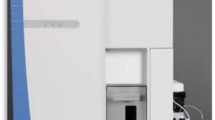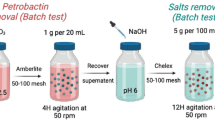Abstract
This study evaluated the performance of inductively coupled plasma mass spectrometry for the determination of platinum (Pt) in rat dorsal root ganglion. The method detection limit was found to be 0.008 ng/mL of Pt, which corresponds to 4 pg of Pt per milligram of ganglia. The standard deviations in the tissue matrix were 5.7% or better and minimum matrix effect was observed. Compared to indium, the use of iridium or a combination of iridium and bismuth as internal standard(s) provided more accurate measurement. The Pt in the tissue digestate was stable for a minimum of 46 d at levels above 0.05 ng/mL. Flow injection analysis using undiluted digestates resulted in approximately 20% signal enhancement. Internal standard correction was necessary to obtain accurate results. The method was used in initial studies in which rats were dosed with cisplatin and has shown that Pt accumulates and persists in dorsal rat ganglion following treatment.
Similar content being viewed by others
References
S. W. Thompson, L. E. Davis, M. Kornfield, R. D. Hilgers, and J. C. Standefer, Cisplatin neuropathy,Cancer 54, 1269–1275 (1984).
R. W. Gregg, J. M. Molepo, V. J. A. Monpetit, M. Z. Mikael, D. Redmond, M. Gadia, et al., Cisplatin neurotoxicity: the relationship between dosage, time, and platinum concentration in neurologic tissues, and morphologic evidence of neurotoxicity.J. Clin. Oncol. 10, 795–803 (1992).
S. Munro, L. Ebdon, and D. J. McWeeny, Applications of inductively coupled plasma mass spectrometry for trace metal determination in foods,J. Anal. Atom. Spectrom. 1, 211–219 (1986).
R. C. Hutton, Technical information, PQ704, VG, Isotopes Ltd., Winsford, Cheshire, UK (1986).
S. Branceh, L. Ebdon, M. Ford, M. Foulkers, and P. O’Neill, Determination of arsenic in sample with high chloride content by inductively coupled plasma spectrometry,J. Anal. Atom. Spectrom. 6, 151–154 (1991).
C. J. Pickeford and R. M. Brown, Comparison of ICP-MS and ICP-ES: detection power and interference effects experienced with complex matrices,Spectrochim. Acta 41B(1-2), 183–187 (1986).
E. M. Thurman and R. L. Malcolm, Preparative isolation of aquatic humic substances,Environ. Sci. Technol. 15, 463–466 (1981).
H. E. Taylor and J. R. Garbarino, Occurrence and distribution of selected trace metals in the international humic substances society’s standard and reference fulvic and humic acids isolated from the Suwannee River, U.S. Geological Survey Open File No. 87–557 (1990).
A. W. Boom, J. E. Fulford, and W. Wegscheider, Determination of trace elements in organic materials by inductively coupled plasma spectrometry,Mikrochim. Acta 2, 171–178 (1985).
J. R. Dean, R. C. Massey, and L. Ebdon, Selection of mode for the measurement of lead isotope ratios by ICP-MS and its application to milk powder analysis,J. Anal. Atom. Spectrom. 2, 369–374 (1987).
O. Nygren, G. T. Vaughan, T. M. Florence, G. M. P. Morrison, L. M. Warner, and L. S. Dale, Determination of platinum in blood by adsorptive voltammetry,Anal. Chem. 62, 1637–1640 (1990).
B. Rietz, J. Heydorn, and A. Krarup-Hansen, Determination of platinum by neutron activation analysis in nerve tissue from rats treated with cisplatin,Biol. Trace Element Res. 47, 343–350 (1994).
T. Minami, M. Ichii, and Y. Okazaki, Comparison of three different methods for measurement of tissue platinum level,Biol. Trace Element Res. 48, 37–44 (1995).
P. Tothill, L. M. Matheson, J. F. Smyth, and K. McKay, Inductively coupled plasma mass spectrometry for the determination of platinum in animal tissues and a comparison with atomic absorption spectrometry,J. Anal. Atom. Spectrom. 5, 619–622 (1990).
D. C. Gregoire, Determination of platinum, palladium, ruthenium and iridium geological materials by inductively coupled plasma mass spectrometry with sample introduction by electrothermal vaporization,J. Anal. Atom. Spectrom. 3, 309–314 (1988).
B. J. Perry, R. R. Barefoot, and J. C. Van Loon, Inductively coupled plasma spectrometry for the determination of platinum group elements and gold,Trends Anal. Chem. 14, 388–397 (1995).
P. Allain, S. Berre, Y. Mauras, and A. Le Bouil, Evaluation of inductively coupled plasma spectrometry for the determination of platinum in plasma,Biol. Mass Spectrom. 21, 141–143 (1992).
B. J. Perry and R. E. Balazs, ICP-MS methods for the determination of platinum in suspensions of cells exposed to cisplatin,Anal. Proc. Includ. Anal. Commun. 31, 260–271 (1994).
B. Casetta, M. Roncadin, G. Montanari, and M. Furlanut, Determination of platinum in biological fluids by inductively coupled plasma spectrometry,Spectroscopy 12, 81–86 (1991).
A. Montaser and D. W. Golightly,Inductively Coupled Plasmas in Analytical Atomic Spectrometry, 2nd ed., VCH, New York, Chap. 13 (1992).
D. R. Lide,CRC Handbook of Chemistry and Physics, 72nd ed., CRC, Boca Raton, FL (1991).
S. Greenfield, H. M. McGreachin, and P. B. Smith, Nebulization effects with acid solutions in ICP spectrometry,Anal. Chim. Acta 84, 67–78 (1976).
E. G. Chudinoz, I. I. Ostroukhova, and G. V. Varvanina, Acid effects in ICP-AES,Fresenius Z. Anal. Chem. 335, 25–33 (1989).
M. Thompson and M. H. Ramsey, Matrix effects due to calcium in inductively coupled plasma-atomic emission spectrometry,Analyst 110, 1413–1422 (1985).
S. R. Koirtyohann, J. S. Jones, C. P. Jester, and D. A. Yates, Use of spatial emission profiles and a nomenclature system as aids in interpreting matrix effects in the low power argon inductively coupled plasma,Spectrochim. Acta 36B, 49–59 (1981).
Author information
Authors and Affiliations
Rights and permissions
About this article
Cite this article
Ding, H., Goldberg, M.M., Raymer, J.H. et al. Determination of platinum in rat dorsal root ganglion using ICP-MS. Biol Trace Elem Res 67, 1–11 (1999). https://doi.org/10.1007/BF02784270
Received:
Accepted:
Issue Date:
DOI: https://doi.org/10.1007/BF02784270




